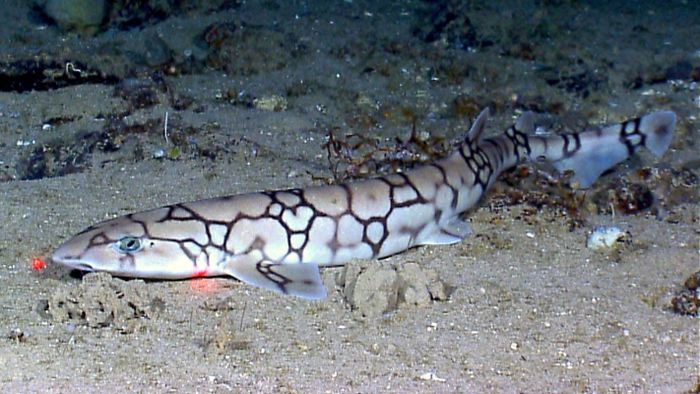Glow-in-the-Dark Sharks
Learn everything about the interesting glow-in-the-dark sharks from this comprehensive article.


Glow-in-the-Dark Sharks
Sharks are ancient creatures that have masterfully dominated the waters of the world. But one thing people don’t know about these masterful predators is that some of them can glow in the dark.
In the simplest of terms, bioluminescence is when living organisms are able to create or produce light. This is usually achieved through chemical reactions in their bodies and is most abundant in marine organisms, both vertebrates and invertebrates.
Having the ability to create light greatly benefits animals that live in deep and dark waters, as it can assist in hunting prey and may even be used to communicate with one another. However, the primary use of bioluminescence in marine organisms is camouflage from predators below them via counter-illumination. It does this by making their outlines and shadows “disappear” by appearing to blend in with the light filtering through the surface of the water.

Out of the 550 species of sharks that we know of, approximately twelve percent are bioluminescent. Some of these include the chain catshark, cookie cutter shark, and the swell shark, which all emit a faint green hue. While there are far too many glowing sharks to list all of them in this article, there are, however, two main groups, namely the lantern sharks and kitefin sharks.
Lanternsharks are still somewhat of an enigma, especially since they are the smallest shark species that live in the deeper, largely uncharted parts of the ocean. However, scientists agree that they are one of the most successful species at surviving, with new species constantly being discovered every few years. They emit a light glow from their bellies which come from several minuscule organs called photophores. However, it's still scientifically unclear today exactly how they can produce the light.
One example is the velvet belly lanternshark, which uses its light as a warning sign. Its sharp spines behind the back fins are lined with photophores and look like glowing swords or lightsabers when lit up. Visible from a distance of up to four meters away, this gives any approaching predators enough of a warning while still not advertising their presence in the water.
Bioluminescence may also be used as a form of communication, and the Etmopterus lanternsharks are a good example. Each species has unique patterns of photophores on its flanks, which may act as a way to identify each other. As the shark swims, it can also appear as if its glow is flashing on and off, even though it's emitting at a steady glow, and may be used as a visual morse code of sorts. Scientists also believe that these "flashes" prevent cross-breeding with other species, which is useful when there are other sharks in the dark parts of the ocean.
Since most sharks have bioluminescent bellies, finding it in other parts of their bodies is most likely a product of long and gradual evolution and natural selection. Over time, some of the organs with photophores may have adjusted their positions slightly throughout the generations until eventually reaching the positions they were at today. Since the bioluminescent lanternsharks were able to identify each other better, finding, a mate and breeding became a more successful venture in the dark.
In 2020, researchers discovered three new bioluminescent sharks on the eastern coast of New Zealand: the kitefin shark (Dalatias licha), the blackbelly lanternshark (Etmopterus lucifer), and the southern lanternshark (Etmopterus granulosus). Their findings produced significant interest in the scientific world, which were published in the Frontiers in Marine Science journal, where they outline how the sharks produced a blue-green light in their skin.

These three sharks are known to dwell in an area of the ocean that doesn’t receive a lot of sunlight, called the mesopelagic zone. Also known as the “twilight zone”, this area is approximately 200 to 1000 meters (660 to 3,300 feet) below the surface.
What makes these sharks unique is that they don’t have luciferin, which is the chemical compound that produces light when it interacts with oxygen. The researchers hypothesize that the sharks control the light with melatonin instead, which is the same chemical that helps us go to sleep. What isn’t clear is how they can control it or turn the light on and off. To date, these sharks are the only known bioluminescent organisms that can control their light with hormones.
What makes Dalatias licha an exciting discovery is that it's officially the largest organism known that can produce light, reaching lengths of up to almost six feet. They are also the only sharks known to have a luminescent dorsal fin and have a unique kind of dermal denticle or shark scale.
Their underbellies glow a light blue, which is most likely a form of counter-illumination that helps to camouflage itself from threats below, even though its only known predators are other larger sharks. It may use its glow to light up the area around it to help it search for food, or it may serve as a disguise to fool its prey. On the other hand, the faint glow on the dorsal fin is believed to serve as a form of communication or as a way to attract potential mates.
With so much uncharted territory below the surface of the water, there are so much more new species waiting to be discovered. Glow-in-the-dark sharks may sound eerily frightening, but it’s also fascinating how these ancient creatures have evolved throughout the years to adapt to their surroundings.


